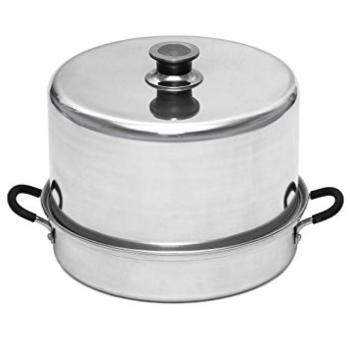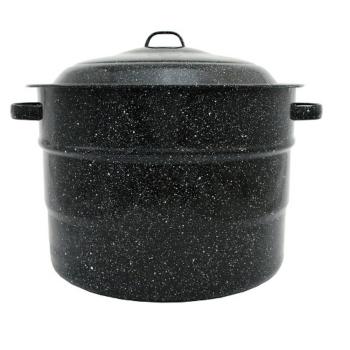High-Acid Foods
Processing High-Acid Foods
Food that has enough acidity to keep the pH of the product below 4.6 can be processed in a water-bath canner or a steam canner.
|
|

Atmospheric Steam Canner
|

Water-Bath Canner
|
Examples of items commonly water-bath or steam canned include:
- Pickles
- Salsa
- Fruit
- Jams and Jellies
- Tomatoes (with added lemon juice)
Some borderline acidic food are further acidified with ingredients like lemon juice, lime juice, or vinegar.
When a recipe calls for vinegar, it is important to always use 5% vinegar. Food scientists use this level as a standard. Using a weaker strength vinegar can lead to an unsafe product. (Homemade vinegar and some rice vinegars are often not 5%.)
For recipes calling for lemon or lime juice, always use bottled juice. Bottled juices have a standardized level of acidity. Fresh lemons and limes can vary in strength.
Do not substitute or reduce the amounts of acid ingredients called for in recipes.
Tip: recipes with a lot of vinegar such as pickles and mustard will mellow and improve in flavor after a couple weeks of rest.
Steam Canning
Although they have been around for decades, using atmospheric steam canners to process high-acid foods (pH<4.6) has been tested and approved by the UC Cooperative Extension for home canning.
We like steam canners because they are lighter to move and take less energy to heat up than traditional boiling water-bath canners.
While steam canners are now considered safe, their use varies slightly from water-bath canning.
This fact sheet from UC covers how to safely use steam canners and is worth reading if you are new to this type of equipment.
The processing time for steam canning is the same as water bath canners.
Note: It is important that while your food is processing that the lid does not move around or "burp." This can allow cold air to enter as the lid rises, cooling the contents for the canner.
Pickled Chileno Peppers
(Click here to view as its own page.)
This recipe from Colorado State Cooperative Extension was chosen for its similarity to a popular style of pickling our local Chileno peppers.*
Always process peppers correctly to be safe. DO NOT OPEN KETTLE.
Pickled Chileno Peppers
- 5 lbs chileno peppers, approx. 4 quarts
- 1 clove garlic per jar
- 6 cups 5% vinegar
- 2 cups water
- 1 tablespoon plus 1 teaspoon pickling salt
- 1 tablespoon sugar, if desired
Yield: Makes 7 to 8 pints
Procedure: Wash peppers. Cut two small slits in each pepper. Pack one clove garlic and peppers tightly into clean, hot jars, leaving 1/2-inch headspace.
Combine vinegar, water, salt and sugar, if using. Bring to boil and reduce to simmer. Pour hot pickling solution over peppers, leaving 1/4-inch headspace.
Remove air bubbles. Readjust headspace to 1/4 inch. Wipe jar rims. Add lids pre-treated to manufacturer’s instructions and process in boiling water or atmospheric steam canner for the time specified for your altitude and jar size. For best flavor, store jars five to six weeks before opening.
Boiling water bath or steam canner processing time:
| Altitudes of: | ||
| Jar size | Below 6,000 ft | Above 6,000 ft |
| Pints or ½-pints | 10 min | 15 min |
| Quarts | 15 min | 20 min |
*Modified according to original recipe's instructions which explicitly allows substitution of peppers. Source.
